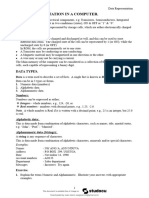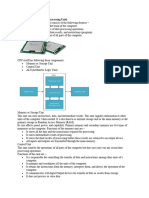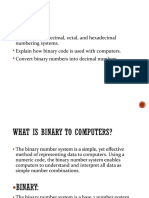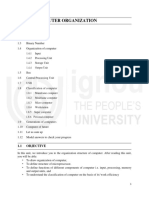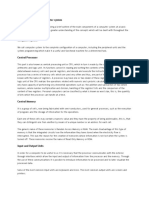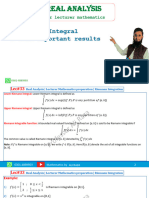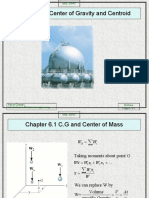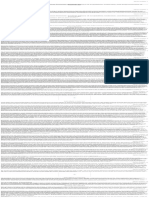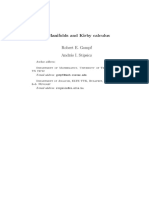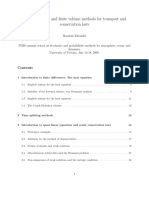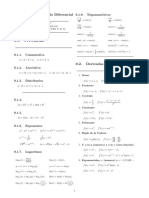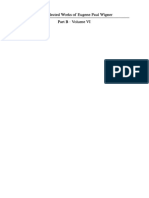Chapter2 1
Uploaded by
michealehaftu69Chapter2 1
Uploaded by
michealehaftu69Chapter-2
Data Representation and Numbering System
I. Data vs. information
Data can be defined as any type of representation of an object or an event. Representation could
be in the form of, number, text symbols, and voice, static or dynamic image and so on.
Information can be defined as a processed or summarized data for a particular analysis or
decision making.
Digital computers store data using two state components. With two such states, we can represent
exactly two different values. These two values correspond to the two digits used by the binary
number system or base 2 that requires just two symbols, _ 0_ 1, but the pattern remains the same
as for decimal. The digits are termed binary digits. bits.
II. Data Processing
Data processing is the process of converting data in to information. More generally the term data
processing can apply to any process that converts data form one formats to another, for this
perspectives, data processing becomes the processes of converting data in to information and
also the conversion of information in to another further processed information. Data processing
may be done manually, mechanically, electronically. For our lesson we give emphasis on
electronic data processing. The process usually assumed to be automated and running on a
personal computer, it involves three steps: input, processing, and output.
Basic Data processing cycle
Input Processing Output
That is a computer gets input through an input device such as a mouse or a keyboard, processes it
according to the set of instructions given to it, and generates an output.
Basics Operations of data processing
The following are the basic operations during data processing electronically.
1. Input refers to anything that is given to a computer for processing. It may take various
forms such as numbers for calculation, text to be printed, sound etc.
2. Processing is the process of data transformation in to useful information. During the
operation useful actions like arithmetic operation, sorting, classifying and summarization
Compiled by: G/kirstos Page 1
may made on the row data. The computer has to be told what to do with the input. That
means a computer must be programmed with the set of instructions it is required to
perform.
3. Output refers generating the processed data ( information) to the user using different
devices
Additional data processing operations:
Dissemination is dispatching the information to the appropriate user through
communication Medias.
Storing is accumulating the processed data for later use or processing.
Extended data processing cycle
Data processing
Disseminating
Addition
Input Subtraction
Division Out put
Row data multiplication
Processed data
sorting
(information
expertise knowledge
Classification etc...
Storing
Storing Storing
For later processing For lateruse
III. Data Representation and Numbering Systems
1. Data Representation
Data representation refers to the methods used to represent information stored in a computer. We
know that the computer is an electronic device and it works using electrical signals. Electrical
signals can represent only two states: on and off, so any information that has to be processed by
a digital computer has to be converted in to a format of these two states. These two states
correspond to the two digits 0 and 1used by the binary number system.
1 bit = one on or off position
1 byte = 8 bits
Compiled by: G/kirstos Page 2
Computers store many different types of information such as numbers, text, graphics of several
varieties (still image, video, animation), and sound. All types of information are stored in a
computer in the same simple format: 0's and 1's. How can 0's and 1's represent things as diverse
as your photograph, your favorite song, a recent movie, and your letter? It all depends on how we
interpret the information. Computers use numeric codes based on the binary number system to
represent all the information they store. Computers use a variety of different codes. Some are
used for numbers, others for text, and still others for sound and graphics.
Units of Data Representation: Bit, Byte, Word
The entire circuitry of the computer is designed on the basis of binary system. The Binary
number system is a group of zeros and ones. It is obvious that computer’s net intelligence is
absolutely zero i.e. computer is not capable of understanding anything except zeros and ones. In
computer every instruction is interpreted and executed in the form of binary system. From the
readability point of view it is very difficult to understand the string of bits. It is also very difficult
to write and understand the instruction or program written in binary form. Therefore, the
programs are generally written in high-level language or Assembly language. Later on these
programs are converted into machine language with the help of appropriate translators such as
Compiler, Assembler or Interpreter.
The basic unit of the memory is a Bit. A Bit is an abbreviation for a Binary digitand can
be either a 0 or a 1.
Group of continuous 4 bits is termed as Nibble.
Eight adjacent bits designed to store the binary code of a single character (letter, decimal
digit or other character) is referred as Byte.
A word is a fixed-sized group of bits that are handled together by the machine. The
number of bits in a word (the word size or word length) is an important characteristic of
computer architecture.
A Word consists of 32 bits, which is equal to 4 bytes (this depends on the computer i.e.,
a word may contain 8, 16, or 32 bits). Commonly used notation in modern computers is
32 bits.
Double word is 2 times a word.
Frequently capacity of memory is represented in terms of K(Kilo) , which is equivalent to
1024 words of 8 bits each ( 210 bytes).
1 KILO = 1024 bytes (approx. 103 bytes) These are all the
1 MEGA = 103 K B approximate values
1 GIGA = 103 M B
1 TERA = 103 G B B stands for Byte
1 PETA = 103 TERA B
Why Binary representation is used in computers?
Compiled by: G/kirstos Page 3
A computer’s internal storage techniques are different from the way people represent
information in lives.
Information inside a digital computer is stored as a collection of binary data (0’s and 1’s)
The logic that computer uses is Boolean logic which is a two valued logic and thus the
two states of a binary system can relate directly to two states in a logical system.
It was easier to make hardware which can distinguish between two values than multiple
values.
Other bases need more circuitry as compared to binary and this reduced reliability.
This binary system simplifies the design of the circuits, reduces the cost and improves the
reliability.
Every operation that can be done in decimal system can also be done in binary.
Number Systems
Every computer stores numbers, letters, and other special characters in a coded form. Before
going into the details of these codes, it is essential to have a basic understanding of the number
system. So the goal of this chapter is to familiarize you with the basic fundamentals of number
system. Number systems are basically of two types: non positional and positional.
Non-Positional Number Systems
In this system, we have symbols such as I for 1, II for 2, III for 3, IIII for 4 etc. Each symbol
represents the same value regardless of its position in the number and the symbols are simply
added to find out the value of a particular number. Since it is very difficult to perform arithmetic
with such number system, positional number systems were developed as the centuries passed.
Positional Number Systems
In the early days Non-Positional number system was very difficult to use, as it had no symbol for
0. History says that the 0 was invented in India. The positional number systems are Binary,
Octal, Decimal and Hexa-decimal. In positional number system there are only a few symbols
called digits, and these symbols represent different values depending on the position they occupy
in the number. The value of each digit in such a number is determined by three considerations.
The digit itself.
The position of the digit in the number, and
The base or radix of the number system(where base is determined as the total number of
digits available in the number system)
We will introduce here 4 positional number systems
Decimal Number System
Binary Number system
Hexadecimal Number System
Octal Number System
Decimal Number System
The number system that we use in our day-to-day life is called the Decimal number system.
Decimal number system is a base 10 system which means there are 10 digits starting from 0 to
Compiled by: G/kirstos Page 4
9 to represent any quantity.The position of each digit in a decimal number system is
represented as a power of the base (10).
o Value of the digits depends on the position they hold. For e.g :
4th 3rd 2nd 1st
Total Value: 4*100+2*101+0*102+1*103 = 1024
103 102 101 100 Thus any number can be represented by using the available
1 0 2 4 digits and arranging them in various positions.
Binary Number System
The Binary Number system is a base 2 system with only two digits 0 and 1. Each position
in a binary number represents a power of the base (2).
Octal Number System
Octal Number System is a base 8 system. So in this system there are only eight symbols or
digits: 0,1,2,3,4,5,6,7. Each position in octal number represents a power of the base 8. Since
there are only 8 digits in the octal number system, 3 bits are sufficient to represent any octal
number in binary.
Hexadecimal Number System
Hexadecimal number system is a base 16 system with 16 digits namely
0,1,2,3,4,5,6,7,8,9,A,B,C,D,E,F; Where A represents decimal 10, B represents decimal 11 , C
represents decimal 12, D represents decimal 13, E represents decimal 14 and F represents
decimal 15.
Comparative Representation of Number Systems
Hexa
Decimal
Binary System Octal System decimal
System
System
0 0 0 0
1 1 1 1
2 10 2 2
3 11 3 3
4 100 4 4
5 101 5 5
6 110 6 6
7 111 7 7
8 1000 10 8
Compiled by: G/kirstos Page 5
9 1001 11 9
10 1010 12 A
11 1011 13 B
12 1100 14 C
13 1101 15 D
14 1110 16 E
15 1111 17 F
: : : :
: : : :
Base Conversion: Converting From One Number System to Another
(Double-Dabble Method)
Converting to Decimal from another Base
(a) Integer Part Conversion
Step 1: Determine the positional value of each digit.
Step 2: Multiply the positional value by the digits in the corresponding columns.
Step 3: Sum the products obtained in step 2. The total is the equivalent value in decimal.
(b) Decimal Part Conversion
For converting a fraction of binary system into decimal the following steps should be followed:
Step 1: Multiply each digit of binary from left to right by base–1, base–2, base–3 and base–4....
respectively.
Step 2: Simplify the arithmetic expression and add them together to find the required fraction of
decimal system.
Step 3: Now by combining both the converted parts we can find the decimal equivalent of the
binary number.
Binary to Decimal
(For conversion of an binary number to a decimal number the base / radix will be 2)
Example 1 Convert binary (1100)2 to decimal form.
Solution
Digit Positional value(Step 1) Step 2
0
0(right most digit) 2 0*20
0 21 0*21
1 22 1*22
1 23 1*23
Total (Step 3) 4+8=12
Therefore 11002 =1210
Example 2Convert binary (11101101.10101)2 to decimal form.
Solution
Integer part – 11101101
Fractional part – 10101
Compiled by: G/kirstos Page 6
Conversion of integer part:
1×2 + 1×2 + 1×2 + 0×2 + 1×2 + 1×2 + 0×2 + 1×2
7 6 5 4 3 2 1 0
1×128 + 1×64 + 1×32 + 0×16 + 1×8 + 1×4 + 0×2 + 1×1
128 + 64 + 32 + 0 + 8 + 4 + 0 + 1
(237)10
Conversion of fractional part:
Starting from left to right each bit is multiplied by
2–1, 2–2, 2–3, 2–4...... we find
1 0 1 0 1
———–––––––––
1×2–1 + 0×2–2 + 1×2–3 + 0×2–4 + 1×2–5
.50 + 0 + .125 + 0 + .03125 = (.65625)10
By combining both the resultant values we get the final decimal equivalent value (237.65625)10
Useful Tips
+ve Power of 2Equivalent value –ve Power of 2 Equivalent values
20 1 2–1 .50
21 2 2–2 .25
22 4 2–3 .125
3
2 8 2–4 .0625
24 16 2–5 .03125
25 32 2–6 .015625
26 64 2–7 .0078125
27 128 2–8 .00390625
28 256 2–9 .001953125
29 512 2–10 .000976562
10
2 1024 2–11 .000488281
Note : A binary number having all 1s and without fractional part can be
converted into decimal number system by the following direct conversion
formula : 2n-1, where n is the total number of bits in the binary number.
Example
Convert Binary 11 into its decimal equivalent: (11)2= (?)10
Here n = 2 2n–1 = 22–1 = (3)10
Octal to Decima
(For conversion of an octal number to a decimal number the base / radix will be 8.)
Example 1Convert octal number (172)8 to decimal (?)10
Solution
Conversion of integer part: Starting from right multiply each digit by its positional value , we find
1 7 2
1×82 + 7×81 + 2×80
1×64 + 7×8 + 2×1
Compiled by: G/kirstos Page 7
64 + 56 + 2
(122)10.The converted decimal equivalent value we find is (172)8 = (122)10
Example 2Convert (342.671)8 to decimal (?)10 form.
Solution
Integer part – 342
Fractional part – 671
Conversion of integer part
3 4 2
3×8 2 + 4×81 + 2×80
3×64 + 4×8 + 2×1
192 + 32 + 2
(226)10
Conversion of fractional part
Starting from left to right each digit is multiplied by 8–1, 8–2, 8–3, 8–4...... we find –
6 7 1
6×8 –1 + 7×8 –2 + 1×8–3
0.75 + 0.1093 + 0.00195 = (0.86125)10
By combining both the converted values we get the final decimal equivalent (226.86125)10 +ve
Power of 8 Equivalent values –ve Power of 8 Equivalent values
0
8 1 8–1 .125
1 –2
8 8 8 .015625
2 –3
8 64 8 .00195312
3 –4
8 512 8 .0002441406
4 –5
8 4096 8 .00003051757
5 –6
8 32768 8 .00000381469
86 262144 8–7 .00000047683
: : : :
: : : :
Hexadecimal to Decimal
(For the conversion of Hexa - decimal to a decimal number the base/radix will be 16. )
Example 1 Convert hexa-decimal number (3DF)16 to decimal (?)10
Solution
Conversion of integer part :
Starting from right multiply each digit by nth bit × 16n-1, we find
3 D F
3×16 + 13×16 + 15×160
2 1
3×256 + 13×16 + 15×1
768 + 208 + 15
(991)10
The converted decimal equivalent value is – (3DF)16 = (991)10
Example 2Convert (5DE.1A)16 to decimal (?)10 form.
Compiled by: G/kirstos Page 8
Solution
Integer part – 5DE
Fractional part – 1A
Conversion of integer part-
Starting from right multiply each digit by nth bit × 16n-1, we find –
5 D E
5×16 + 13×16 + 14×160
2 1
5×256 + 13×16 + 14×1
1280 + 208 + 14
(1502)10
Conversion of fractional part
Starting from left to right each digit is multiplied by 16–1, 16–2, 16–3, 16–4... we find
1 A
1×16 + 10×16–2
–1
+
0.0625 + 0.039062 = (0.101562)10
by combining both the values we get the final decimal equivalent.
(1502.101562)10
Compiled by: G/kirstos Page 9
+ve Power of 16 Equivalent value –ve Power of 16 Equivalent value
160 1 16–1 .0625
161 16 16–2 .0039062
162 256 16–3 .00024414062
163 4096 16–4 .00001525878
164 65536 16–5 .00000095367
165 1048576 16–6 .0000000596
166 16777216 16–7 .00000000372
: : : :
Converting From Decimal to a New Base
(a) Integer part conversion
Steps:
Step 1: Divide the decimal number to be converted by the value of the new base.
Step 2: Record the remainder from step 1 as the rightmost digit (Least Significant Digit) of
the new base number.
Step 3: Divide the quotient of the previous division by the new base.
Step 4: Record the remainder from step 3 as the next digit (to the left) of the new base
number.
Repeat steps 3 and 4 recording remainders from right to left, until the quotient becomes zero in
step 3. Note that the last remainder thus obtained will be the most significant digit (MSD) of the
new base number.
(b) Fractional part conversion
(1) In this method we multiply given fractional part by ‘base’ and write down the
Fractionalparts and integer parts of the products in the separate columns.
(2) The successive fractional parts of the products are multiplied by base till the fractional part
of the product becomes 0 or up to the desired accuracy.
(3) The integer part of the product is written in downward direction ( ) to find the binary
equivalent of the decimal fraction.
Example 1
Decimal to Binary Decimal to Octal Decimal to Hexadecimal
2510 =? 2 95210 =? 8 42810 = ?16
Q R Q R Q R
25 952 428
12 26
1 0 1
6 3 1 119 `
3 =1 10 12
0 0
=1 A C 16
1 14 7 0
1 7 1
Compiled by: G/kirstos Page 10
6
= 110012 1
=16708
Compiled by: G/kirstos Page 11
Example 2
Find the Binary equivalent of (75.68)10 = (?)2
Solution
Integer part conversion
Dividend divisor = Quotient (Remainder)
75 2 = 37 1 LSD
37 2 = 18 1
18 2 =9 0
9 2 =4 1 (1001011)2
4 2 =2 0
2 2 =1 0
1 2 =0 1 MSD
Fractional part conversion -
Process Product Decimal part Integer part
0.68 × 2 1.36 .36 1 MSD
0.36 × 2 0.72 .72 0
0.72 × 2 1.44 .44 1 (10101)2
0.44 × 2 0.88 .88 0
0.88 × 2 1.76 .76 1 LSD
Now the combined string of converted integer and fractional part will be
(75.68)10 = (1001011.10101)2
Example 3
Find the Octal equivalent of (634.640625)10 = ( ? )8
Solution
Integer part conversion
(Divisor) Dividend divisor = Quotient (Remainder)
8 634 8 = 79 2 R1 LSD
8 79 8 = 9 7 R2
8 9 8 = 1 1 R3 (1172)8
8 1 8 = 0 1 R4MSD
Fractional part conversion
Process Product Decimal part Integer part
0.640625 × 8 5.125 .125 5 MSD
0.125 × 8 1.00 .00 1 (510)8
0.00 × 8 0.00 .00 0 LSD
Compiled by: G/kirstos Page 12
Now the combined string of converted integer and fractional part will be -
(634.640625)10 = ( 1172.510 )8
Compiled by: G/kirstos Page 13
Example 4
Find the Hexa-decimal equivalent of (3634.6505)10 = ( ? )16
Solution
Integer part conversion
(Divisor) Dividend divisor = Quotient (Remainder)
16 3634 16 = 227 2 R1 LSD
16 227 16 = 14 3 R2 (E32)16
16 14 16 = 0 14 = E R3 MSD
Fractional part conversion
Process Product Decimal part Integer part
0.6505 × 16 10.408 .408 10 = A MSD
0.408 × 16 6.528 .528 6
0.528 × 16 8.448 .448 8 (0.A6872)16
0.448 × 16 7.168 .168 7
0.168 × 16 2.688 .688 2 LSD
Now the combined value of converted integer and fractional part will be -
(3634.6505)10 = (E32.A6872 )16
Converting From A Base Other Than 10(Decimal) To Base Other Than 10
(Decimal)
Step 1: Convert the original number to a decimal number (base 10)
Step 2: Convert the decimal number so obtained to the new base.
Eg: 3456 =? 4
First, Convert 3456 into its equivalent decimal.
=5*60+4*61+3*62
=5+24+108
=13710
Now, convert 137 10 =? 4
137 1
34 8 2
8 2 0
22
So, 3456 = 20214
Shortcut Method for Binary to Octal Conversion (Direct method)
(a) Integer part conversion
Step 1: Divide the binary digits into groups of three (starting from the right). If any last group does
not have sufficient bits to make the pair of 3 bits then some 0 bits can be included to the left to make the
group of 3 bits.
Compiled by: G/kirstos Page 14
Step 2: Convert each group of 3 binary digits into one octal digit. Since decimal digits 0 to 7 are
equal to octal digits 0 to 7, binary to decimal conversion can be used in this step.
(b) Fractional part conversion
Step 1: Here the grouping of 3 bits is done from left to right and if any last group does not have sufficient
number of bits then adequate zeros can be included to the right of the last group.
Step 2: Now each group of bits is converted into its octal equivalent number.
Step 3: After this if integer part is present all the equivalent octal numbers of integer parts and fractional
parts are combined to find the final octal equivalent number.
Step 4: At last the decimal point is fixed at the appropriate position according to the mathematical
conventions.
Octal Binary
0 000
1 001
2 010
3 011
4 100
5 101
6 110
7 111
Example 1
Find the octal equivalent of (10101.01101)2 = (?)8
Solution
(10101.01101)2 = (25.32)8
Shortcut Method For Octal To Binary Conversion
Step 1: Convert each octal digit to a 3 digit binary number. (Here octal digits are
considered as decimals.)
Step 2: Combine all the resulting binary groups into a single binary number.
Example 1
Find the binary equivalent of (2172.01)8
Solution
The 3 bits binary combinations of octal equivalent digits are as follows
Octal Binary
2 = 010
Compiled by: G/kirstos Page 15
1 = 001
7 = 111
0 = 000
By combining all the 3 bits binary combinations we get–
2 1 7 2 . 0 1
010 001 111 010 000 001
(2172.01)8 = (010001111010.000001)2
Shortcut Method for Binary to Hexadecimal Conversion
(a) Integer part conversion
Step 1: Divide the binary digits into groups of four. (Starting from the right)
Step 2: Convert each group of four digits to one hexadecimal digit. Hexa decimal digits 0
to 9 are equal to decimal digits 0 to 9, and hexa decimal digits A to F are equal to decimal 10 to
15. Hence the binary to decimal conversion procedure can be used, but the decimal values 10 to
15 must be represented as hexa decimal A to F.
(b) Fractional part conversion
Step 1: The grouping of 4 bits is done from left to right and if any last group does not have the sufficient
number of bits then adequate 0s can be included to the right of the last group.
Step 2: Now each group of bits is converted into its hexa-decimal equivalent number.
Step 3: After this all the equivalent hexa-decimal numbers of integer parts and fractional parts are
combined to find the final hexa-decimal equivalent number.
Step 4:Lastly the decimal point is fixed at the appropriate place according to the mathematical
conventions.
Example 1
Find the hexa-decimal equivalent of (100001011.000011) = (?)16
Solution
(10B.0C)16
Shortcut Method for Hexadecimal to Binary Conversion
(a) Integer part conversion
Step 1: Convert the decimal equivalent of each hexa digit to a 4 digit binary number.
Step 2: Combine all the resulting binary groups into a single binary number.
(b) Fractional part conversion
Step 1: The grouping of 4 bits is done from left to right and if any last group does not have the sufficient
Compiled by: G/kirstos Page 16
number of bits then adequate 0s can be included to the right of the last group.
Step 2: Now each group of bits is converted into its hexa-decimal equivalent number.
Step 3: After this all the equivalent hexa-decimal numbers of integer parts and fractional parts are
combined to find the final hexa-decimal equivalent number.
Step 4: Lastly the decimal point is fixed at the appropriate place according to the mathematical
conventions.
HEXA- Binary
DECIMAL
0 0000
1 0001
2 0010
3 0011
4 0100
5 0101
6 0110
7 0111
8 1000
9 1001
A 1010
B 1011
C 1100
D 1101
E 1110
F 1111
Example 1
Find the binary equivalent of (AC4.16F)16 = (?)2
Solution
The group of 4 binary bits of hexa-decimal equivalent numbers is as follows:
Hexa-decimal Binary
A = 1010
C = 1100
4 = 0100
1 = 0001
6 = 0110
F = 1111
By concatenating (combining) all the 4 bit binary combinations we get
A C 4 . 1 6 F
Compiled by: G/kirstos Page 17
1010 1100 0100 0001 0110 1111
(AC4.16F)16= (101011000100.000101101111)2
How to Represent Negative Numbers on Computers?
Using,
1. Sign And Magnitude Method
2. One’s Complement Method
3. Two’s Complement Method
Sign and Magnitude Method
Left most bit of the binary number is used to represent whether the number is positive (+)
or negative (-).
Left most is the Most Significant Bit (MSB) and is know as sign bit in this method.
If the sign bit is 1 the number is negative and if it is 0 the number is positive.
Sign bit is the MSB, with magnitude being a binary number using the remaining bits.
Eg: +5 = 0 101
-5 = 1 101
One’s Complement Method
All the 1 bits is changed to 0 and all the 0 bit is changed to 1 to get the complement of a
number.
One’s Complement of the number is treated as the negative of that number.
Eg: +5 = 0 101
-5 = 1 010
Two’s Complement Method
Two’s complement of a number is one’scomplement of a number+ 1.
Two’s complement of a number is treated as the negative representation of the number.
Eg: +5 = 0 101
-5 = 1 011
2’s complement of 5 = 1’s complement of 5 +1 = 1010 +1 = 1011
Note: Consider the representation of zero in all the above methods.
Sign and One’s Two’s Complement
Magnitude Complement Method
Method Method
Compiled by: G/kirstos Page 18
+0 0000 +0 0000 +0 0000
-0 1000 -0 1111 -0 1 0000
Zero has two different representations in sign and magnitude method and one’s complement
method which is not correct. But in 2’s complement method there is only one way
representation for zero. And so 2’s complement method is used in modern computing.
Computer Arithmetic:
Binary Addition
Is performed in the same manner as in decimal arithmetic.
Since 1 is the largest digit in the binary number system, any sum greater than 1 requires a digit to be carried
over.
0 +0 0
0+1 1
1+0 1
1+1 0 plus a
carry of 1
Binary Subtraction – is applied to subtraction of numbers in other number systems.
1. Determine if it is necessary to borrow.
2. If the subtrahend (the lower digit) is larger than the minuend (the upper digit), it is necessary to borrow
form the column to the left.
3. It is important to note here that the value borrowed depends upon the base of the number system.
4. Simply to subtract lower value from the upper value.
Example:
Subtract 011102 from 101012
Answer - 001112
0–0 0
1–0 1
1–1 0
0–1 1 with a
borrow
from the
next
column
Binary Multiplication – also follows the same general rules as multiplication in decimal number system.
0X0 0
0X1 0
1X0 0
1 X1 1
Compiled by: G/kirstos Page 19
Binary Division – it is similar to decimal division. The rules for binary division are:
1 Start from the left of the dividend
2 Perform a series of subtractions, in which the divisor is subtracted from the dividend.
3 If subtraction is possible, put a 1 in the quotient and subtract the divisor form the corresponding digits of
dividend.
4 If subtraction is not possible (divisor greater than remainder), record a 0 in the quotient.
5 Bring down the next digit to add to the remainder digits. Proceed as before in a manner similar to long
division.
0÷1 0
1 ÷1 1
Compiled by: G/kirstos Page 20
To be continue -------------------------------
Compiled by: G/kirstos Page 21
You might also like
- Chapter - Three: Basics of Information, Data, Data Processing and Data RepresentationNo ratings yetChapter - Three: Basics of Information, Data, Data Processing and Data Representation50 pages
- Data Representation: Unit 2 By: Dipti Purohit Izee Business School BangaloreNo ratings yetData Representation: Unit 2 By: Dipti Purohit Izee Business School Bangalore52 pages
- Data Representation and Data ProcessingNo ratings yetData Representation and Data Processing32 pages
- Digital vs Analog: Computer Data RepresentationNo ratings yetDigital vs Analog: Computer Data Representation15 pages
- Chapter Three Data Representation in ComputersNo ratings yetChapter Three Data Representation in Computers21 pages
- Chapter 1.4 Data: Its Representation, Structure and Management 1.4 (A) Number Systems and Character SetsNo ratings yetChapter 1.4 Data: Its Representation, Structure and Management 1.4 (A) Number Systems and Character Sets23 pages
- Chapter: 1.1 Data Representation: Page 1 of 8No ratings yetChapter: 1.1 Data Representation: Page 1 of 88 pages
- Lecture 6 ICT Number System Decimal Binary 01042022 121104pm 20042022 091746amNo ratings yetLecture 6 ICT Number System Decimal Binary 01042022 121104pm 20042022 091746am29 pages
- Unit 3 - Data Representation For ProcessingNo ratings yetUnit 3 - Data Representation For Processing7 pages
- Basic Description of A Computer System. Assembler Language Basic Concepts Using Debug ProgramNo ratings yetBasic Description of A Computer System. Assembler Language Basic Concepts Using Debug Program13 pages
- Intro To Numbering Systems and Data RepresentationNo ratings yetIntro To Numbering Systems and Data Representation4 pages
- Chapter 4 - Data Representation Computer File SystemsNo ratings yetChapter 4 - Data Representation Computer File Systems9 pages
- Macroeconomics - 1 Handout (AgEc 1071 in Adu)No ratings yetMacroeconomics - 1 Handout (AgEc 1071 in Adu)80 pages
- Class 12 Maths Notes Chapter 1 Studyguide360No ratings yetClass 12 Maths Notes Chapter 1 Studyguide36011 pages
- Structural Topology Optimization - Moving Beyond Linear Elastic deNo ratings yetStructural Topology Optimization - Moving Beyond Linear Elastic de13 pages
- Chapter 6: Center of Gravity and CentroidNo ratings yetChapter 6: Center of Gravity and Centroid30 pages
- Trigonometry Solutions Exercise - 7.1: ExercisesNo ratings yetTrigonometry Solutions Exercise - 7.1: Exercises22 pages
- A Solution To Plato's Problem - The Latent Semantic Analysis Theory of Acquisition, Induction, and Representation of KnowledgeNo ratings yetA Solution To Plato's Problem - The Latent Semantic Analysis Theory of Acquisition, Induction, and Representation of Knowledge4 pages
- Common Tangents and Tangent Segments 0 PDFNo ratings yetCommon Tangents and Tangent Segments 0 PDF68 pages
- Pearson Edexcel Level 1/level 2 GCSE (9 - 1) in Mathematics (1MA1)No ratings yetPearson Edexcel Level 1/level 2 GCSE (9 - 1) in Mathematics (1MA1)27 pages
- Probability & Statistics - Final Exam - Solutions.Practice 2No ratings yetProbability & Statistics - Final Exam - Solutions.Practice 213 pages
- F13 Lecture 1 Intro To Numerical MethodsNo ratings yetF13 Lecture 1 Intro To Numerical Methods17 pages
- Schools Division Office of Isabela: Jones Rural School-300555No ratings yetSchools Division Office of Isabela: Jones Rural School-3005554 pages
- Linear Algebra and Polynomial AssignmentNo ratings yetLinear Algebra and Polynomial Assignment2 pages
- Guy Brousseau, Nadine Brousseau, Virginia Warfield (Auth.) Teaching Fractions Through Situations - A Fundamental Experiment 2014 PDFNo ratings yetGuy Brousseau, Nadine Brousseau, Virginia Warfield (Auth.) Teaching Fractions Through Situations - A Fundamental Experiment 2014 PDF226 pages
- Exponential Functions, Equations and InequalitiesNo ratings yetExponential Functions, Equations and Inequalities35 pages
- Chapter 1 - Understand Numbering SystemNo ratings yetChapter 1 - Understand Numbering System30 pages
- Finite Difference and Finite Volume Methods For Transport and Conservation LawsNo ratings yetFinite Difference and Finite Volume Methods For Transport and Conservation Laws56 pages
- Jagdish Mehra Auth., Jagdish Mehra Eds. Philosophical Reflections and SynthesesNo ratings yetJagdish Mehra Auth., Jagdish Mehra Eds. Philosophical Reflections and Syntheses630 pages













